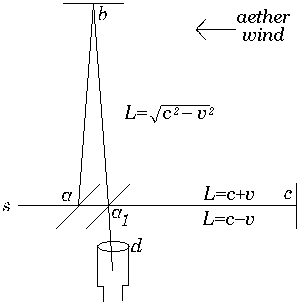The Michelson-Morley Experiment
Or, the demise of the aether and the complete reconsideration of physics
![]()
![]()
This says as much about physics teachers as it does about physicists. The experiment's still worth knowing, though.
 |
With the theorized aether wind of velocity v blowing towards the left, the light traveling straight into it (toward mirror C) would have a velocity (according to Newton) of c - v; coming back, its velocity would be c + v. The light traveling perpendicular to the aether (toward mirror B) would cover the same distance but with a velocity equal (according to Pythagoras) to (c^2-v^2)^(1/2). Thus the time the light travels would be the distance (L) over the rate, or L/(c-v) + L/(c+v) for the light that travels to mirror C, and 2L/((c²-v²)^(1/2)) for the light that travels to mirror B. The two beams of light should arrive at different times, according to this reasoning; by some mathematical manipulation that we will not show here (because we hate having to write equations this way; you can figure it out yourself) we arrive at an approximate (because of the use of the binomial expansion theorem, unshown) time difference of 2Lv²/c³. The point is, they were expecting the light to arrive out of phase. It didn't. There was no time difference at all -- and this fact has been repeatedly shown many times since. |
Back to the Physics Multiverse
![]()
Maintained by adamse@technologist.com